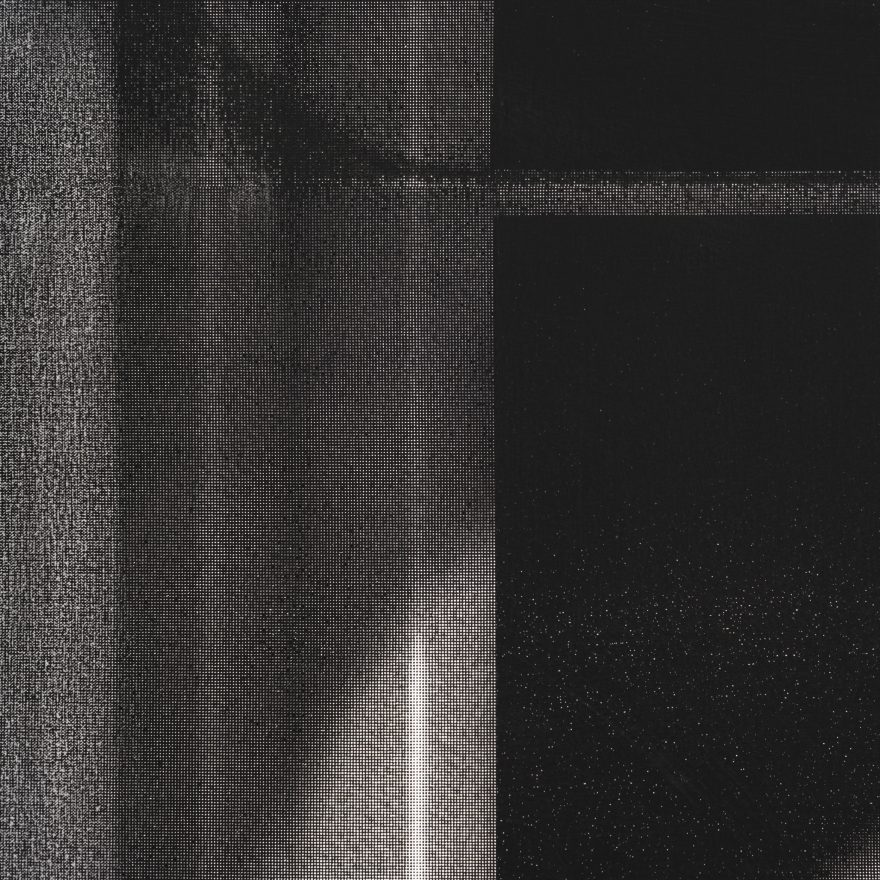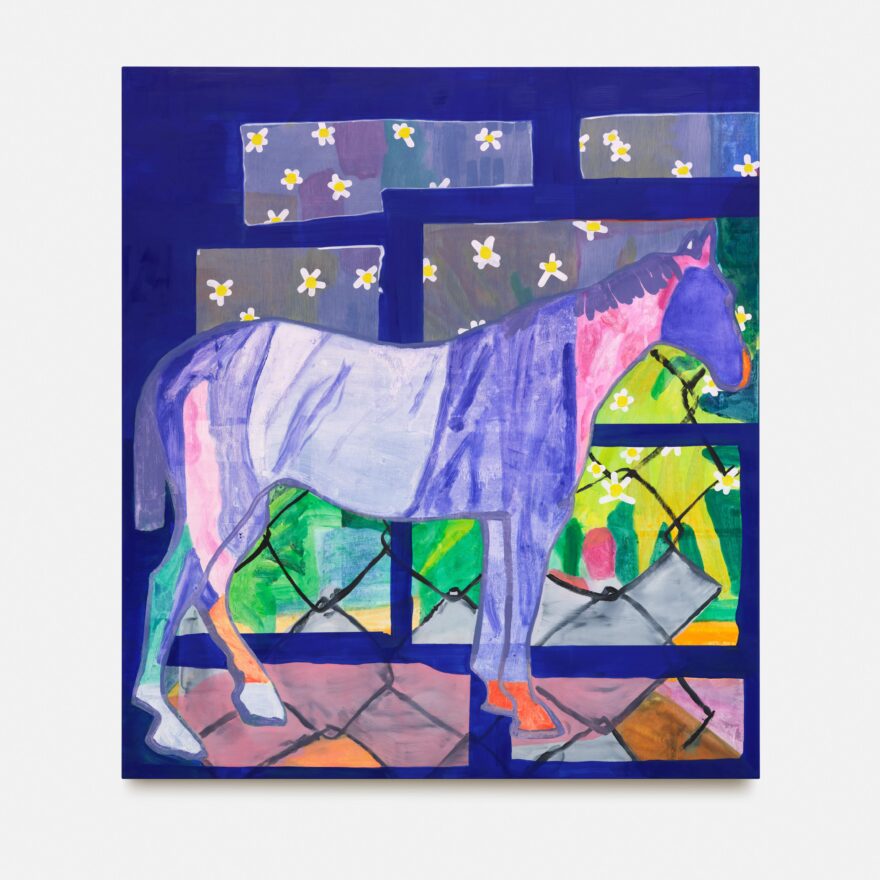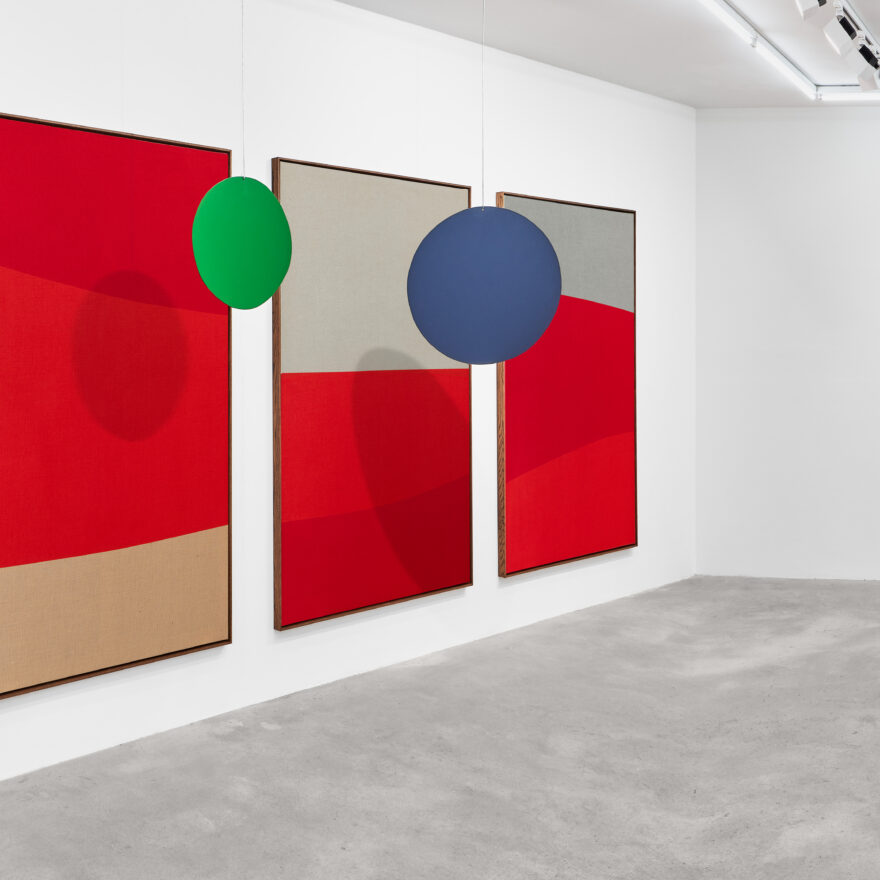Published 4 SEP 2024
Antonio Ballester Moreno
THE MOUNTAIN, THE SKY, THE WIND, THE SKY.
6 JUL until 15 SEP 2024
Tanya Leighton, Berlin is pleased to present ‘THE MOUNTAIN, THE SKY, THE WIND, THE SKY.’, featuring new paintings and sculptures by Madrid-based artist Antonio Ballester Moreno. The exhibition continues the artist’s long-standing meditation on the physics of the natural world using radically simplified forms. This body of work focuses on landscape painting as an object of contemplation. In the West, the genre, in its modern sense, did not come into being until the 16th century when Renaissance humanism popularised the study of nature as an esoteric system of vital geometries. Prior to the 1500s, depictions of nature almost exclusively served as settings for the illustration of religious or state narratives. In other words, nature was merely a backdrop to the theatre of spiritual and political life. It was thus not until the revival of ancient Greek treatises on mathematics that nature suddenly became a theoretical question. It is from this historical moment that the exhibition departs.
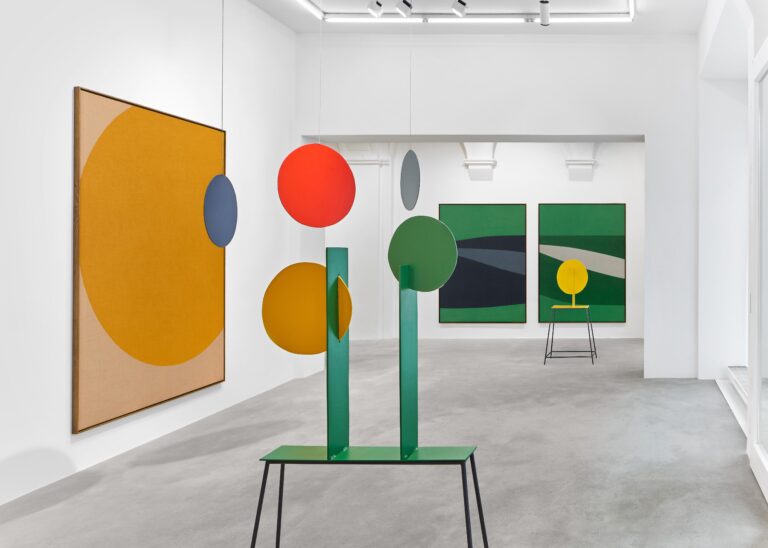
Antonio Ballester Moreno Installation view,
’THE MOUNTAIN, THE SKY, THE WIND, THE SKY.’, 2024
Tanya Leighton, Berlin 6 July – 15 September 2024
Photo: Gunter Lepkowski Courtesy of the artist and Tanya Leighton, Berlin and Los Angeles
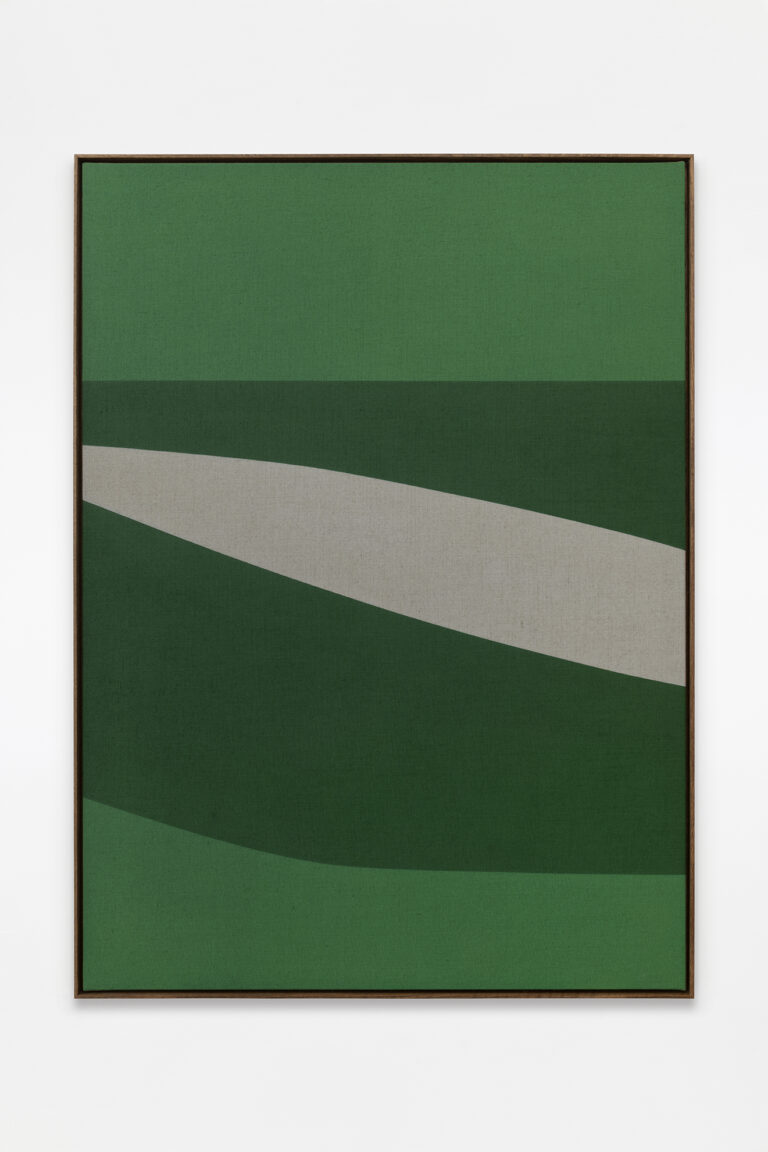
Antonio Ballester Moreno
Green, 2024
Acrylic on jute
200×145 cm
78¾×57⅛ in Unique
(MORENO-2024-0081)
Photo: Roberto Ruiz Courtesy of the artist and Tanya Leighton, Berlin and Los Angeles
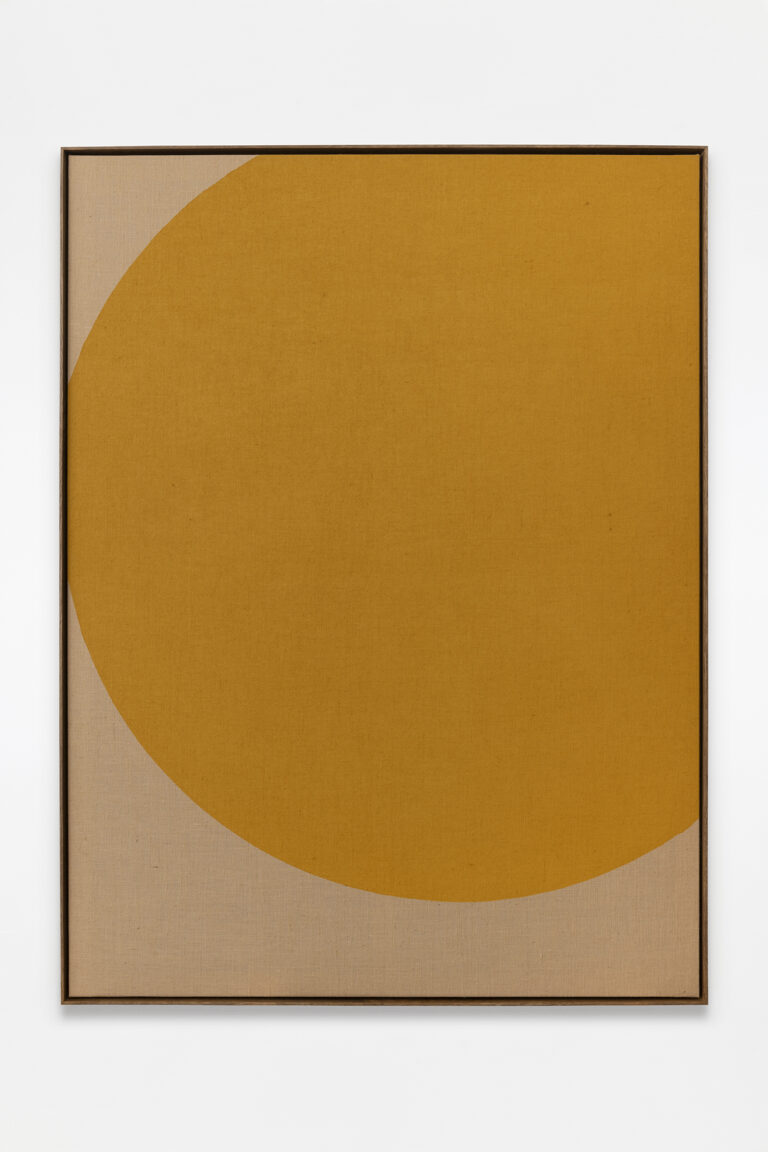
Antonio Ballester Moreno
Yellow, 2024
Acrylic on jute
240×180 cm
94½×70⅞ in Unique
(MORENO-2024-0073)
Photo: Roberto Ruiz Courtesy of the artist and Tanya Leighton, Berlin and Los Angeles
To quote the artist, the works on view should be understood as ‘a scenography of a landscape,’ which is to say that they are not landscapes in a strict sense but rather – at a theatrical remove – an arrangement of elements to produce the impression of a place. In this scenography, every ‘element has a relationship to others,’ such as ‘positive and negative, up and down, light and shadow or day and night.’ It might be said that landscapes are reducible to groupings of terms whose meaning rests on their interdependence. The artist likens this interdependence to binomials, algebraic expressions that cannot be reduced to less than two terms (e.g., x2 + 2). When subject to addition, binomials are commutative, namely they can be inverted without changing the sum of their parts (2 + x2). Commutation belongs to a family of mathematical axioms with which operations with unknown variables can be solved.
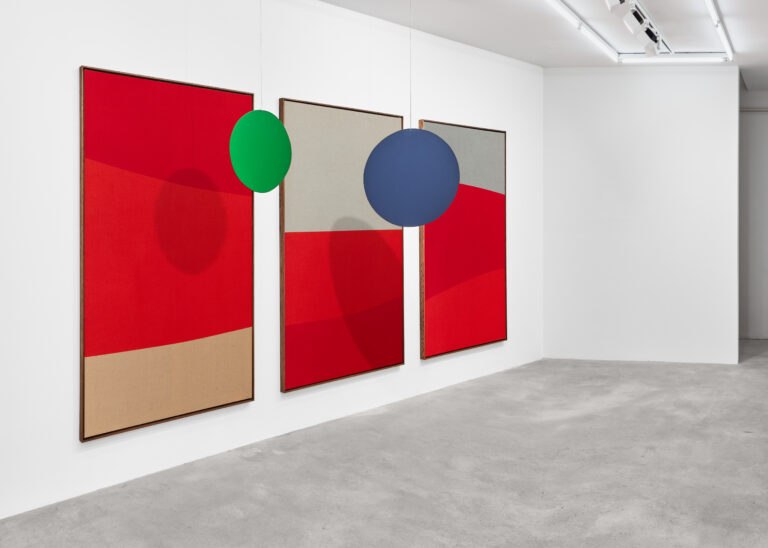
Antonio Ballester Moreno Installation view,
’THE MOUNTAIN, THE SKY, THE WIND, THE SKY.’, 2024
Tanya Leighton, Berlin 6 July – 15 September 2024
Photo: Gunter Lepkowski Courtesy of the artist and Tanya Leighton, Berlin and Los Angeles
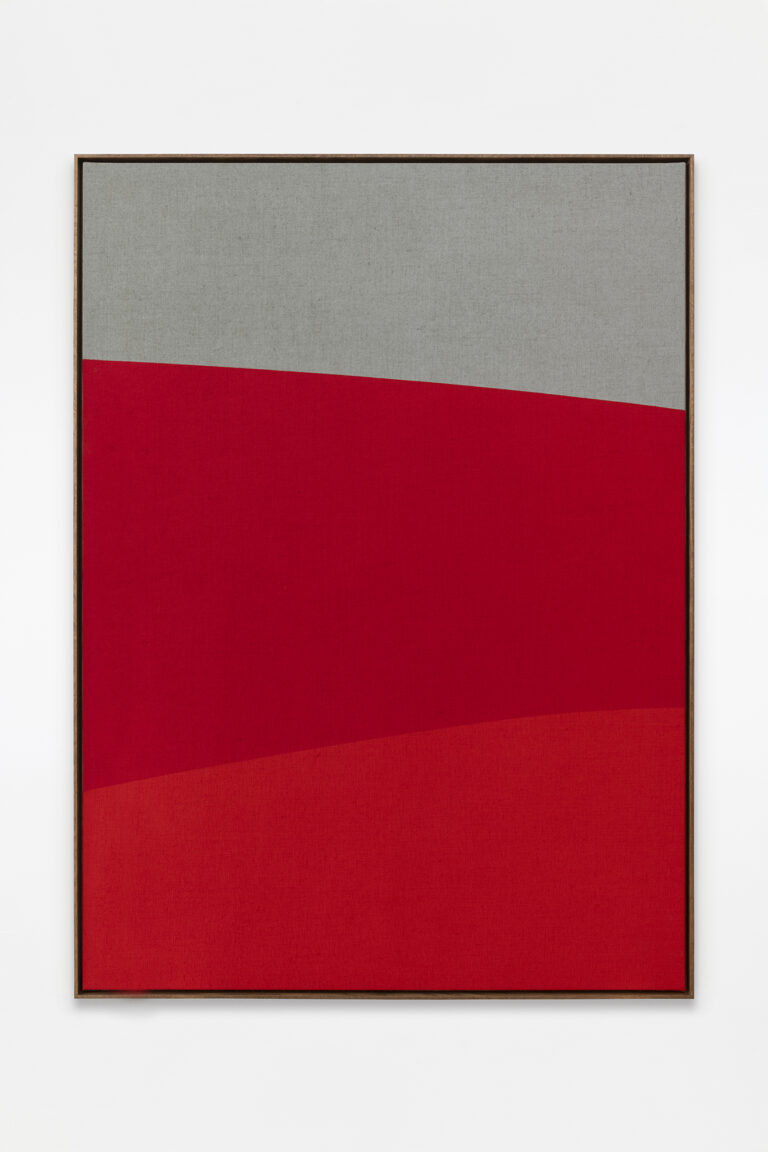
Antonio Ballester Moreno
Red Grey, 2024
Acrylic on jute
200×145 cm
78¾×57⅛ in Unique
(MORENO-2024-0068)
Photo: Roberto Ruiz Courtesy of the artist and Tanya Leighton, Berlin and Los Angeles
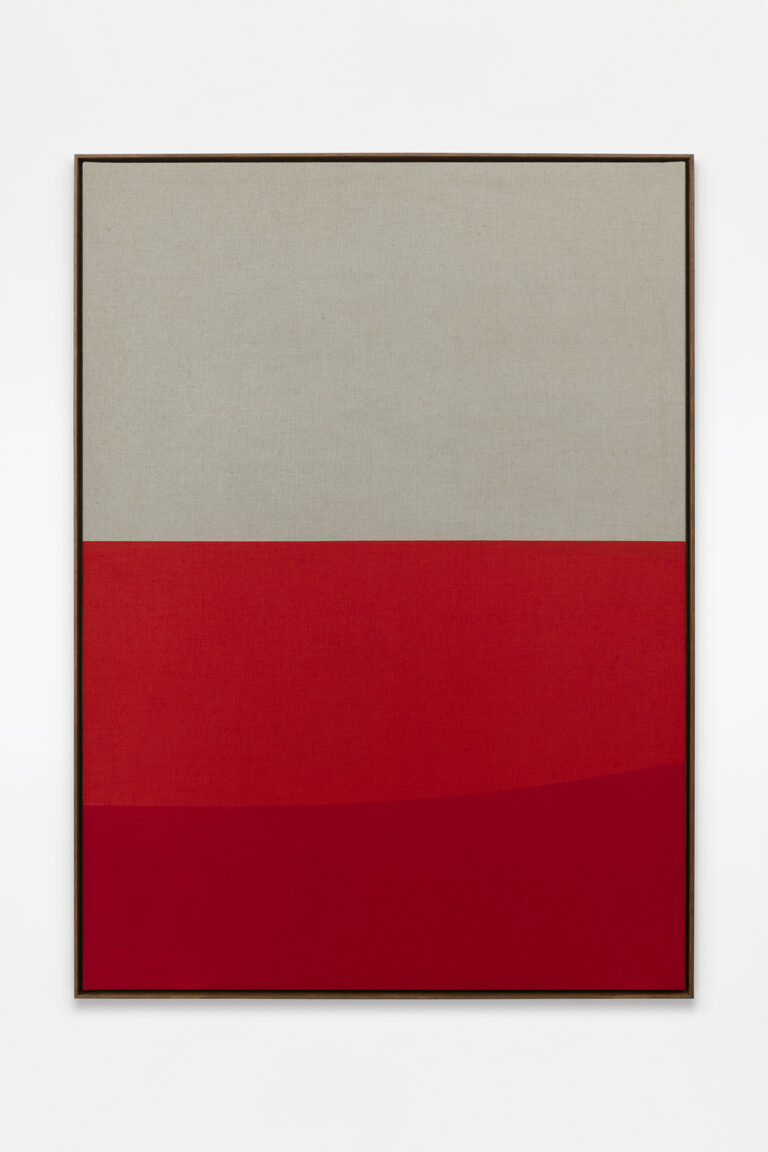
Antonio Ballester Moreno
Red White, 2024
Acrylic on jute
200×145 cm
78¾×57⅛ in Unique
(MORENO-2024-0069)
Photo: Roberto Ruiz Courtesy of the artist and Tanya Leighton, Berlin and Los Angeles
Using algebra as an interpretive lens sheds light on Ballester Moreno’s formal investigations. Take, for example, the paintings of what appear to be rolling hills simplified to iterated ribbons of reds, greens, greys, and yellows. One could imagine such strips of colour rearranged or ‘commutated’ ad infinitum without losing the evocation of a horizon. The artist’s sun sculptures, likewise, reflect a similar interest in inversion by dividing a solar shape into positive and negative outlines, intersected along two axes. Metaphorically speaking, math renders legible how the artist’s radical reduction of form operates on the level of a kind of propositional logic. It is as if each pairing of sculpture and painting were proofs of conditional statements, such as ‘If p, then q’.
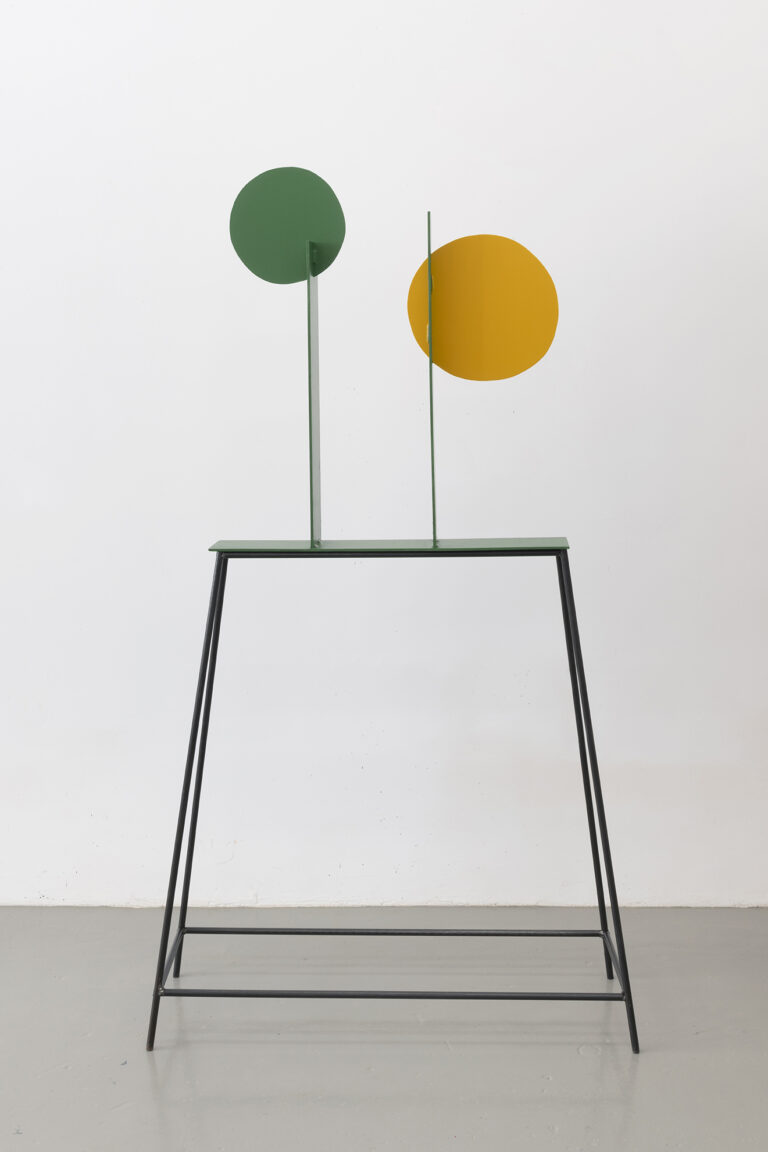
Antonio Ballester Moreno
Green Yellow, 2024
Painted iron
76.5×71.5×12.7 cm
30⅛×28⅛×5 in
(MORENO-2024-0079)
Photo: Roberto Ruiz Courtesy of the artist and Tanya Leighton, Berlin and Los Angeles
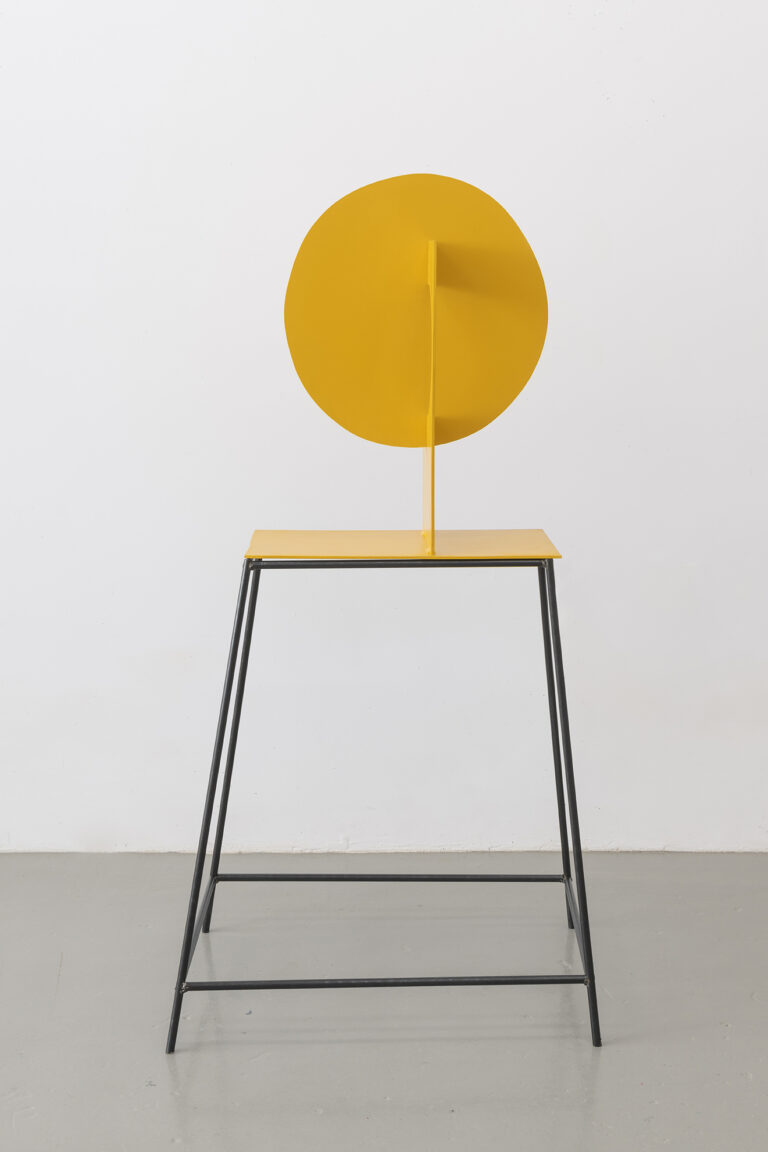
Antonio Ballester Moreno
Yellow, 2024
Painted iron
65×53×27 cm
25⅝×20⅞×10⅝ in
(MORENO-2024-0080)
Photo: Roberto Ruiz Courtesy of the artist and Tanya Leighton, Berlin and Los Angeles
By pushing the analytical study of nature to the extreme, Ballester Moreno leaves his predecessors behind by probing the genre’s inner axioms. In result, he takes his work to the level of the tradition’s flashpoint. Indeed, even the succession of nouns in the exhibition’s title suggest the potential to exhaustively reorder its terms to verify all possible permutations. The work, therefore, imagines the direction the landscape genre might have taken had it not become naturalised as a category of painting. Working against this naturalisation, Ballester Moreno’s art returns the viewer to a time when landscapes were not just there to be painted but rather were a wellspring of hidden knowledge to be discovered.
Han Shen
Desires are already memories
Opening – 13 SEP 2024, 6-8 pm
3 SEP until 28 SEP 2024
Tanya Leighton, Berlin, is pleased to announce ‘Desires are already memories,’ a solo exhibition by Berlin-based artist Han Shen.
The exhibition explores the intricate interplay between longing and remembering, inspired by Italo Calvino’s evocative tales in Invisible Cities. The title itself, a contemplative line from Calvino’s 1972 novel, encapsulates the essence of how our deepest yearnings, once fulfilled, become memories. The traveller, upon reaching Isidora after years of wandering, finds that his youthful desires have transformed into mere memories—a duality that forms the core of Shen’s exploration.
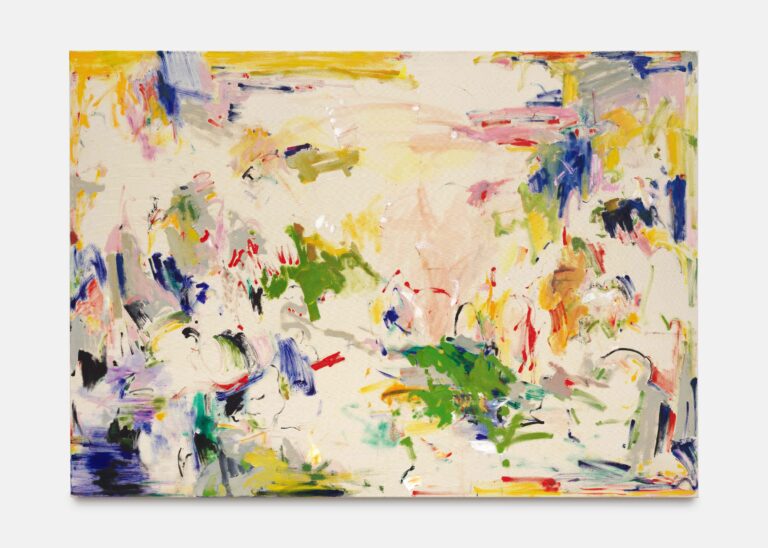
Han Shen
Isidora, 2024
Oil on canvas
150×195 cm
59×76¾ in Unique
(SHEN-2024-0006)
Courtesy of the artist and Tanya Leighton, Berlin and Los Angeles Photography: Gunter Lepkowski
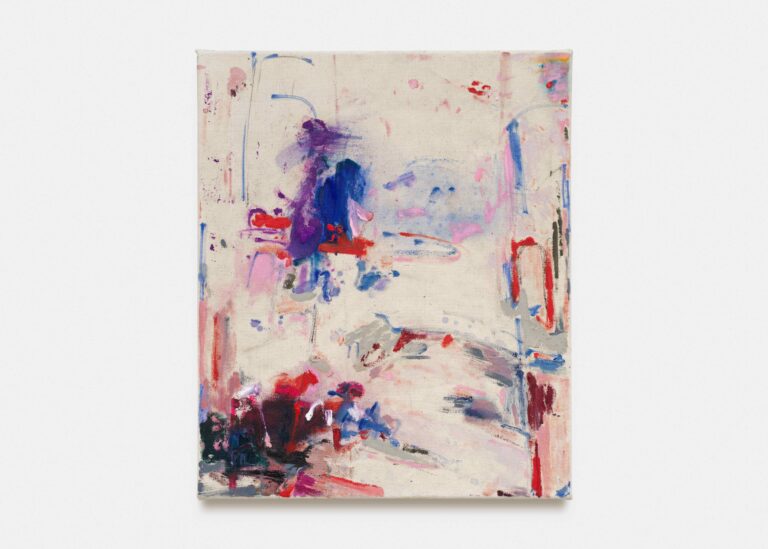
Han Shen
Argia, 2024
Oil on canvas
60×50 cm
23⅝×19¾ in Unique
(SHEN-2024-0002)
Courtesy of the artist and Tanya Leighton, Berlin and Los Angeles Photography: Gunter Lepkowski
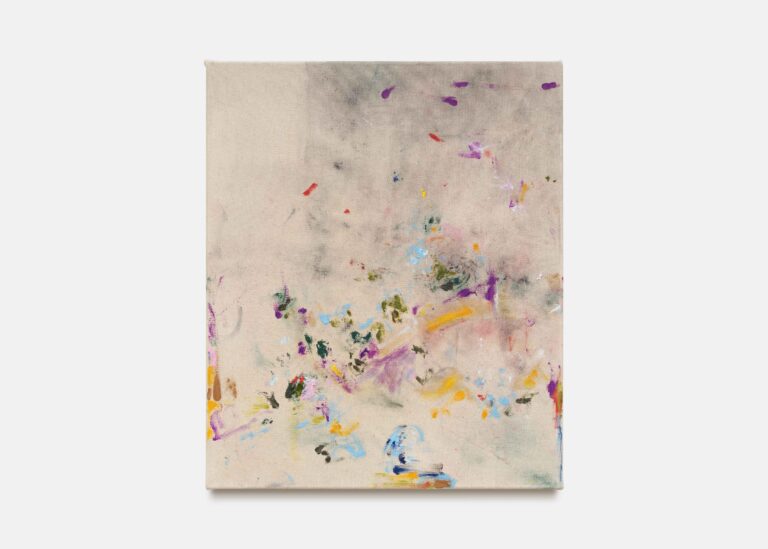
Han Shen
Diomira, 2024
Oil on Canvas
60×50 cm
23⅝×19¾ in Unique
(SHEN-2024-0003)
Courtesy of the artist and Tanya Leighton, Berlin and Los Angeles Photography: Gunter Lepkowski
Shen’s paintings are a visual symphony of fragmented landscapes, where the interplay of colour, form, and gesture invites viewers into a space where time and emotion converge. The unprimed canvas, with its subtle warmth, serves as a foundational element in his exploration of memory and desire. White, not merely an absence, acts as a high note, lifting and highlighting saturated hues, while the interaction of colour spots, lines, and canvas texture creates a complex relationship of positive and negative spaces.
Drawing on Calvino’s reflections on time, Shen uses green and purple to symbolise the metamorphosis of youthful desires into memories. His compositions balance visibility and invisibility, with white space suggesting spatial ambiguity—echoing the ungraspable cities in Calvino’s tales. Shen’s technique, reminiscent of the traditional Chinese concept of ‘liubai,’ or leaving blank spaces, imbues his works with a subtle, ambiguous atmosphere. The natural hue of the unprimed canvas suggests skies, waters, or terrains, while the interplay of colours and lines conjures hidden landscapes.
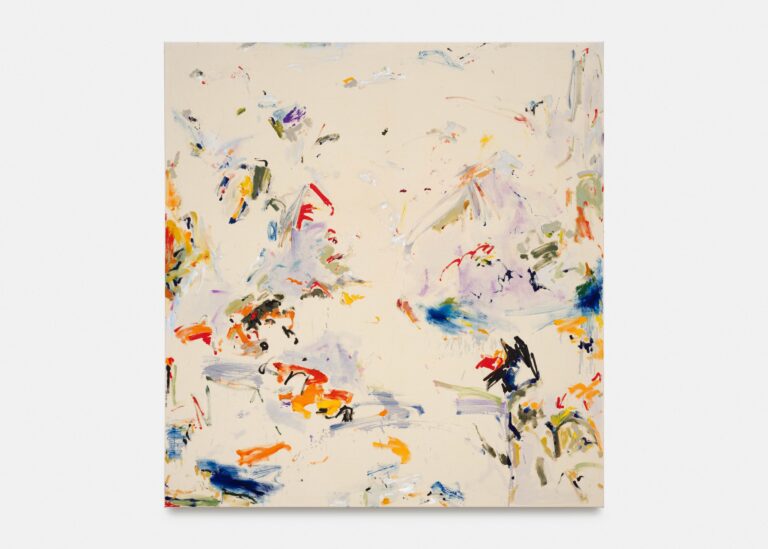
Han Shen
Zemrude, 2024
Oil on Canvas
190×180 cm
74¾×70⅞ in Unique
(SHEN-2024-0007)
Courtesy of the artist and Tanya Leighton, Berlin and Los Angeles Photography: Gunter Lepkowski
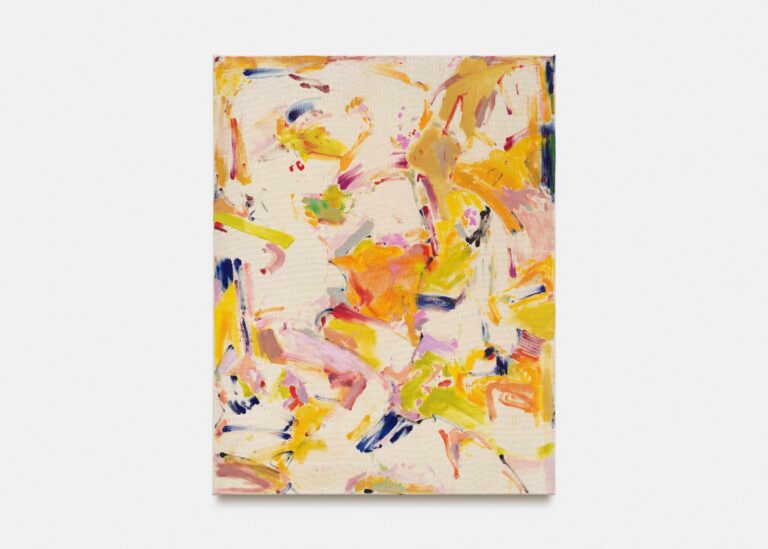
Han Shen
Zaira, 2024
Oil on canvas
90×70 cm
35⅜×27½ in Unique
(SHEN-2024-0004)
Courtesy of the artist and Tanya Leighton, Berlin and Los Angeles Photography: Gunter Lepkowski
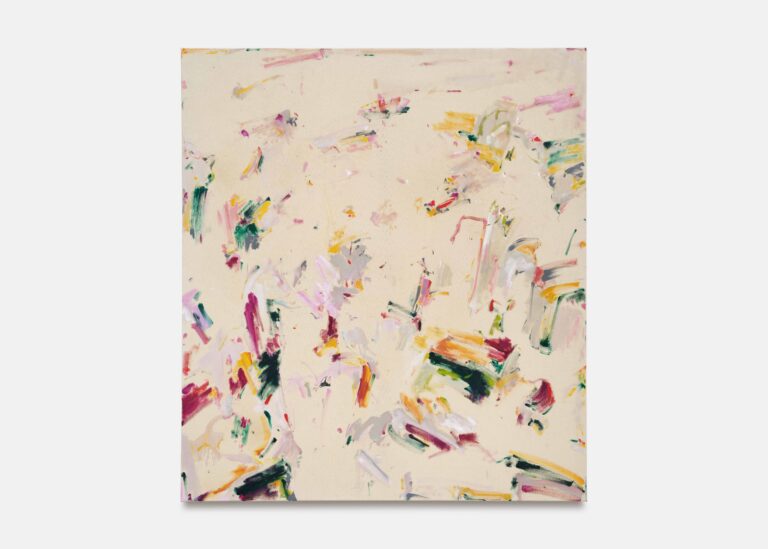
Han Shen
Maurilia, 2024
Oil on canvas
145×130 cm
57⅛×51⅛ in Unique
(SHEN-2024-0005)
Courtesy of the artist and Tanya Leighton, Berlin and Los Angeles Photo: Gunter Lepkowski
Although Shen’s works do not directly depict Calvino’s cities, they share their names, capturing the fleeting, elusive nature of memory. His compositions transcend the depiction of real places, offering visions drawn from memory, where colour and form intertwine to evoke worlds that are transient and ethereal, vanishing as soon as they are spoken of.

